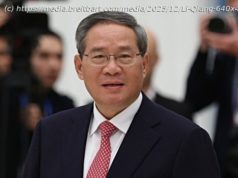It’s more than competition but less than war.
Two related articles from earlier in the week.
Michael Schuman, The Atlantic (“China Has Gotten the Trade War It Deserves“):
A global trade war is starting, and China is at the center of it. A reckoning for Beijing’s economic model, which is designed to promote Chinese industry at the expense of the rest of the world, has long been coming. China’s trading partners have had enough. The result will be a wave of protectionism, with potentially dire consequences for both China and the global economy.
The most obvious and dramatic evidence for this was unveiled [Tuesday] by President Joe Biden, who announced that his administration would quadruple the existing tariffs on imported Chinese electric vehicles, to 100 percent. He will also hike tariffs on steel, aluminum, medical equipment, semiconductors, solar cells, and lithium batteries. The Chinese government instantly protested and threatened action of its own. “The United States should immediately correct its wrong practices,” the Chinese Ministry of Commerce said in a statement. “China will take resolute measures to defend its own rights and interests.”
et China’s leaders have no one to blame but themselves. They joined a global trading system and then gamed that system. Biden’s tariffs are the natural response, though not an entirely positive one. Protectionism raises costs, hurts consumers, shields unworthy companies from competition, and punishes worthier ones. Disputes over trade will only intensify the rivalry between the world’s two great powers.
This souring of trade relations wasn’t always foreordained—but it had become virtually unavoidable. Chinese leader Xi Jinping has failed to reform his economy in ways that would have made this trade war less likely. Facing this confrontation with the United States, he is even less likely to make reforms today. The result is trade conflict and heightened political tensions that benefit no one.
[…]
All governments place their thumb on the scale to promote their national industries to some degree. China’s thumb simply weighs more heavily. A 2022 study by the Center for Strategic and International Studies in Washington conservatively estimated that China spent $248 billion supporting its industries in 2019. That’s twice as much as the United States did.
“It’s the whole financial system, the whole economic system that is leveraged for industrial policy, which is very different than what’s been happening in market economies,” Camille Boullenois, an analyst of Chinese industry at the research firm Rhodium Group, told me. Where electric vehicles are concerned, “it’s very hard to imagine the industry growing as fast without government support.”
[…]
Xi Jinping seems set on making matters worse. His principal economic goal of achieving “self-sufficiency” aims to reduce what China purchases from other countries and substitute goods made by foreign companies with Chinese alternatives—especially in industries, such as green energy, that other governments find strategic. In doing so, Xi is practically inviting more intense trade disputes.






